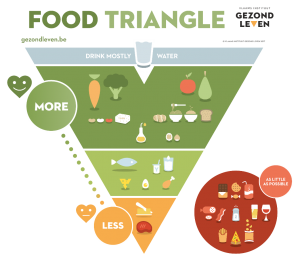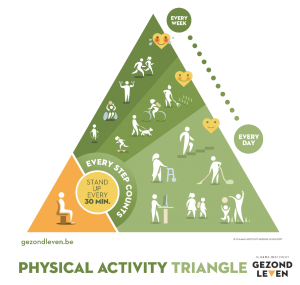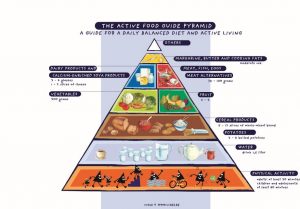New nutrition and physical activity guides have just been published by the Flemish Institute for Healthy Living. Designed to make every citizen aware of what constitutes a healthy lifestyle and to motivate them to make healthy choices, the models are based on a comprehensive analysis of the effectiveness of existing models, the behaviour of citizens, as well as nutrition, physical activity, and communication science.
By Alexandra Latham
The Flemish Institute for Healthy Living (Vlaams Instituut Gezond Leven) aims to provide trustworthy, reliable, and clear information to the public and to 
It realised that new models were needed to explain nutrition and physical activity in ways which are clear and accessible, and which encourage people to start taking small steps to a healthier lifestyles. That’s why, in September 2017 the traditional food and nutrition pyramid in use in Flanders since 1997 was turned on its head, simplified, and split. Citizens are now presented with two triangles – one for nutrition and one for physical activity.
The new models
The models are action-oriented, encouraging gradual progress towards healthier lives. They are accompanied by materials and tools which encourage healthy eating and regular physical activity, and warn against long periods of sedentary behaviour. While the nutrition and activity triangles are for the entire population from aged 1 and up, many of the flanking tools target specific groups such as children, the elderly, or disadvantaged groups.

- Eat proportionally more foods that are derived from plants than foods that are derived from animals.
- Avoid ultraprocessed foods as much as possible.
- Don’t waste food. Moderate your consumption.
The activity triangle stresses the importance of regular movement along with more strenuous daily and weekly activity.
Built on evidence, evaluation, and dialogue
The new models were developed over 21 months in a process which included evidence collection, expert advice, development and testing, and contact with stakeholders.
Scientific evidence and evaluation
The existing pyramid had already been extensively evaluated in 2013. The results of this assessment showed that people – particularly those that had not been introduced to it at school – found it difficult to understand. It lacked a clear, explicit benefit and therefore did not encourage concrete action. The material accompanying the pyramid was assessed as being vague and not reader friendly.
A review of international scientific literature and grey literature on models for diet and nutrition, physical activity and sedentary behaviour was conducted, and accompanied by an assessment of the current behaviour of the Flemish population.
Advice from Experts
The results of the scientific review were brought to a panel of experts on healthy eating, physical activity and sedentary behaviour, and behavioural change and communication. All were linked to non-profit and/or research institutes.
Development

In order to make the models easy to understand for all – particularly disadvantaged groups – it was decided to keep the information in the models limited and clear. The types of food and activities illustrated are just enough to give an overview which is recognisable to all. The language used is kept simple and motivating. Research suggested that including the activity element in the nutrition pyramid meant that impact was lost, so nutrition and activity were separated into separate but visually connected images.
As many people are familiar with the use of a pyramid to explain nutrition, the shape was kept. However, one problem with the pyramid model is that, as we read from top to bottom, we assume the items at the top have high importance – items in the smallest part of the pyramid were regarded as ‘smallest, but most important’. The solution was to turn the nutrition triangle upside down, and to divide the activity triangle using diagonal lines to disrupt the normal reading pattern. ‘Other foods’ were removed from the pyramid completely to clarify what counted as ‘little as possible’ foods.
Testing
To test the models, teenagers (13-15 years old), adults (mostly blue collar workers), seniors (60-80 years old) and people form disadvantaged groups were recruited for focus groups, which assessed how the models were understood and interpreted. Revisions were made after each of the three rounds of focus groups (in total more than 300 people).
Collaboration
Discussions and research were undertaken with teachers, school health services, doctors, dieticians, and physical activity professionals to examine their needs and expectations. After the models had been finalised but before being launched, meetings were held with a large group of stakeholders to explain the reasoning and methodology behind the redesign, to try and raise support.
A model for all
Although the models are for the general public, the Flemish Institute for Healthy Living also targeted professionals such as doctors, dieticians, and teachers in the development and rollout of the campaign as they have an important dissemination role. Recognising the role of the environment in determining (un)healthy choices, the institute also hopes to reach producers, caterers, retailers and policymakers both regionally and nationally.
For more information about the new models and the accompanying resources, visit www.gezondleven.be
Information in English:
- Food triangle
- Physical activity triangle
- Food triangle animated film
- Physical activity triangle animated film
This article was based on the work of Liesbet Dejaegere, programme manager for nutrition and malnutrition, and physical activity and sedentary behaviour.
Alexandra is EuroHealthNet's Senior Communications Coordinator and the editor of EuroHealthNet magazine.
Her main areas of focus are health inequalities and the connections between health and climate change, employment, and ageing.
She is passionate about stories and the way we tell them, creating spaces for dialogue, and new forms of power and decision-making.
You can find her on twitter @AlexandraLatham

